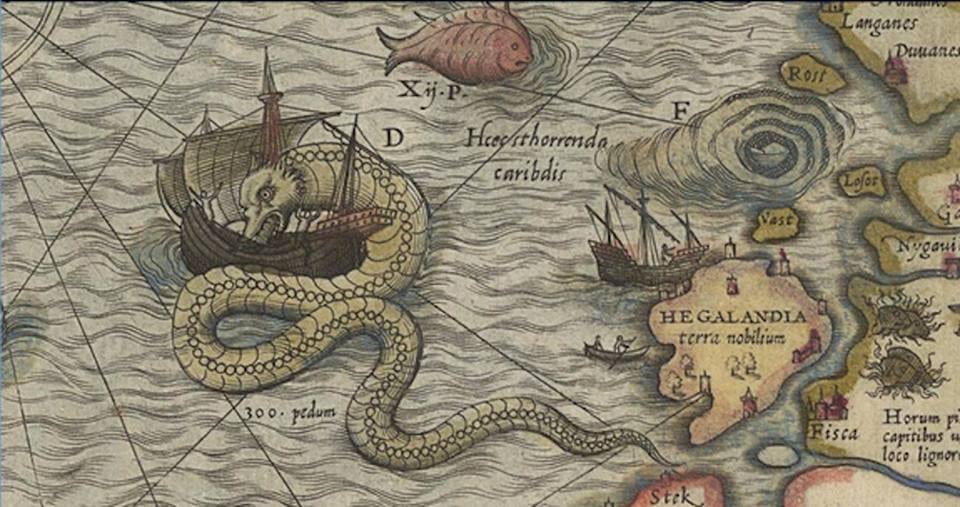What in the world is cryptozoology? Hereinafter abbreviated as CZL, it is the “study of unknown animals.” And what are unknown animals? In the sense I’m using here, these animals are those unknown to science, usually meaning those that have not been measured, dissected, or seen by enough scientists. Yet, some of these animals are very well known and have been seen by many people in many places around the world. A few scientists called cryptozoologists study these unknown animals, try to identify them, and attempt to prove their existence despite claims that these animals are myths, hoaxes, or misidentifications.

A Christian view of CZL is not as important or clearly defined as, for example, a Christian view of dinosaurs. Yet I believe that CZL is something for Christians to look into, as it can often turn up things that disagree with claims of evolution, though not necessarily disprove anything. (Creation can be more easily agreeable to various unknown animals.) This is the main point of this Christian view of CZL, which may or may not be truly the Christian view. There are other points, because a study of CZL shows, better than most other sciences, how limited man’s intelligence really is. And, whether the average zoologist believes it or not, CZL is the cutting edge of zoology. Finally, a study of unknown animals is a great way to practically learn a bit of objectivity, and some biology as well. This will only be an introduction to CZL, hopefully laying the foundation for greater understanding of the situation. So instead of listing these “little known” animals, I want to make this a beginning point for more detailed study, that explains the basics of CZL. [The information in the next 8 paragraphs is taken collectively from the sources noted at the end.]
An unknown animal can be anything from the tiniest insect all the way to a large whale. It can be an animal that, scientifically speaking, is completely unknown, or known as a fossil and presumed extinct, or a surviving example of an otherwise extinct species, or simply a known animal in an unusual location. It can be a fairly close relative of a known animal, or something in a class all by itself. Historically speaking, it can be an animal mentioned obscurely in old (say, ancient Greek) books, or one known only in stories of “primitive” peoples, which stories may blend together both embellished myth and eyewitnessed truth with little or no distinction between the two. Or to put it briefly, I use the term “unknown animal” to mean one undescribed by science, though known somewhat by somebody somewhere sometime. (Sorry, got a little carried away at the end there. Couldn’t resist.)
An unknown animal can exist just about anywhere, but certain parts of the world are more likely than others to have them, especially in cases of relatively large animals. Forests, swamps, and mountains are, of land environments, the most likely to have something unknown. Of water environments, oceans and big, deep lakes are the best for concealment of an unknown animal. These environments clearly have the most room for something to hide.
Yet hasn’t the world’s land been totally explored? How can there still be hiding places remaining, especially for a large animal? Contrary to popular opinion, the world’s land has not been totally explored. Nowadays, an aerial photograph taken from somewhat high altitude often substitutes for ground exploration. Difficult terrain practically demands it. Mountains, swamps, and forests (like rain forest or taiga) are the most difficult. Even ground exploration can miss animals, or result in only fleeting glimpses of them. Besides all of the above, “civilized” men rarely consult the knowledge of “uncivilized” men, who have lived in an area for generations and know their territory inside and out. All things considered, an unknown land animal is not an unreasonable proposition, and is a probable one in wilderness areas.
The ocean is obviously a concealing environment. The deep trenches, which are the least explored places on earth, are quite likely to have many unknown animals. No one would argue with that. However, the idea of an unknown animal that could be large, air-breathing, and often on the surface seems quite ridiculous. After all, there’s so much use of the sea with all the international commerce nowadays, how could an animal of that type remain undiscovered?
International commerce sticks to shipping lanes, since time is money. For an American landlubber example, interstate highways don’t cover much of the country. People driving on them are usually m ore concerned with their destination and the traffic around them, than with the surrounding land, much less any animals it might contain. The noise and motion of a busy highway isn’t very attractive to a wild animal anyway. At night, there are more chances to see wildlife, but those would most likely be only quick glimpses of something in the glare of headlights. I once saw several deer this way.
The same basic principles apply to shipping lanes. As vehicles on a highway are noisy, so the vehicles in shipping lanes are also noisy, with their engines and propellers making them plow through the waves. Such commotion keeps away most sea animals. Ships’ crews are more concerned with their duties and destinations than with the featureless waves surrounding them. They may see an animal, but are not likely to. If they do, it probably will be at a considerable distance, and quickly passed by the ship. The chances of seeing an unknown animal from a modern ship are slim.
A more normal way of seeing animals from a highway is to see their dead carcasses on the side of the road. (I’ve seen many roadkilled armadillos, but have never laid eyes on a living one.) Sometimes however, a roadkill is not identifiable due to its poor condition. So isn’t seeing carcasses washed up on a beach a normal way to see ocean animals? If there are unknown ocean animals, wouldn’t a dead one have washed up onto a beach somewhere?
A carcass in the ocean doesn’t last long, as there are many creatures quite willing to get a free meal. Remains are not likely to last long enough to get to shore. If they do get ashore, it’s somewhat unlikely that anyone will see them, considering how much coastline there is in the world. Of course, carcasses often do wash up in inhabited areas. Sometimes they can be identified, but sometimes their state of decay is too far along to allow identification, or easily allows for much confusion and misidentification. (As was explained previously in “A Christian View of Dinosaurs,” decayed basking sharks have often been mistaken for plesiosaurs.)
So, with all the difficulties of seeing an unknown animal in their environments, how does one go about studying them, both learning about them, and finding them in the field? The best place to start learning about them is the pretty sizable pile of literature on the subject. Nearly all of it that I’ve read is evolutionary in outlook, and some is nearly occultic, so caution is needed. But whatever their outlook, they can offer a lot of information.
Of the material I’ve read, the very best, and most comprehensive, is that written by Dr. Bernard Heuvelmans. His two main works (both quite thick) are On the Track of Unknown Animals and In the Wake of the Sea-Serpents. They were first published in 1959 and 1965, respectively, but are valuable reference books. He is quite objective and thorough, and usually lets even dubious stories speak for themselves before giving his judgment on them. (When discussing fraudulent or suspicious photographs, he includes the photograph so you can decide for yourself.) He packs information in, and teaches the reader a lot about known animals, while discussing unknown animals. Of course, he is entirely evolutionist, this being the only drawback to his books.
Another excellent source is Rumors of Existence, by Matthew Bille. It’s small, and less than 200 pages, but is crammed full of information (19 pages of references!). It’s a list of “newly discovered, supposedly extinct, and unconfirmed inhabitants of the animal kingdom.” Unlike Heuvelmans, Bille steers clear of sensational animals like Bigfoot or the Loch Ness Monster, and sticks to animals which have much more certain evidence of their existence. Therefore, for someone who is rather skeptical of CZL, this book is a good place to start. It also is evolutionary, but not devoutly so. (An autographed copy is available from the author for $15 [postage included]: Matthew Bille, 3405 Windjammer Dr., Colorado Springs, CO, 80920.)
Of course, finding an unknown animal in the field is harder than finding a book in a library. It’s a major undertaking, and not something summed up in a writing of this size. The following are just basic steps, obtained by reading between the lines of books about CZL. Consulting the local inhabitants of an area should always come first. Whatever their education or lack thereof, they know their territory better than anyone else, and have lived in it for generations. Their knowledge is not perfect, and often can confuse several animals (or confuse myth and fact), but they know more than we give them credit for. History would confirm this. With what general knowledge locals can provide, the next step is just ordinary hunting, whether a polite snapshot, or an evil, capitalist gunshot [sarcasm]. Yet this hunting must be a prolonged affair, and not just a quick romp through the woods. As does every CZL writing worth its salt, I here include a quote from Kon-Tiki by Thor Heyerdahl, which explains this point well (for both land and sea). “A sportsman who breaks his way through the woods may come back and say that no wild life is to be seen. Another may sit down on a stump and wait, and often rustlings and cracklings will begin and curious eyes peer out. So it is on the sea, too. We usually plow across it with roaring engines and piston strokes, with the water foaming round our bow. Then we come back and say that there is nothing to see far out on the ocean.” {TH, 117}
Finding an unknown animal in the ocean is obviously more difficult, with three dimensions to work with instead of two. Native inhabitants can’t help as much in this area, an d obviously much of the ocean is far from any human habitation anyway. And in such a vast, foreign environment, it logically would be very hard to purposely search for one animal, even on the surface. When at least some of an animal’s habits are known, such would be possible (the fishing industry being proof), but how does one find an unknown ocean animal? Chance, which really is providence, is the name of the game here. This isn’t anything surprising when relative to the deepest parts of the ocean that few have ever visited, so what I say below is relative to the parts near the surface. The following is, in my opinion, the best way to find an unknown ocean animal.
I wrote earlier about the noisy, modern ships, in which the prospects of seeing an unknown animal are slim. It shouldn’t take a rocket scientist to figure out that a vessel without an engine (and therefore obviously without a propeller) would be a much quieter one, a sailing ship for example. Needless to say, most scientific excursions in the ocean do not use sailing ships. Away from shipping lanes and quietly propelled by the wind, there would be a greater chance to see something unknown. But what may be the best way involves a raft named Kon-Tiki, the book with that name having just been mentioned three paragraphs ago.
Thor Heyerdahl was interested in finding out how the present inhabitants of Polynesia originally came to the islands. Due to various pieces of evidence, his theory was that they had gone west from South America on rafts, propelled by ocean currents. By examining reports of early Spanish explorers who saw oceangoing rafts (in the area of modern Peru), he got enough of a detailed description of the rafts to be able to build one. He and several other men rode this raft from Peru to Polynesia in 1947, proving the possibility of Heyerdahl’s theory.
Down on the surface of the ocean as they were, they could closely observe various inhabitants of it. The men occasionally had practical lessons in CZL. Several times, they saw fish they could not identify {TH, 155}. At night, they would often see unidentified lights moving around underwater {TH, 118-119}. One night, a fish jumped aboard, landing on one of the crew. He was accustomed to the flying fish that often did the same, so he grabbed this fish to get it off him. Unlike a flying fish, what he grabbed was something snaky. After getting it into light, it was seen to be a long, thin fish. The fish was shown to a sleepy crewmember who said, “No, fish like that don’t exist,” and then went back to sleep. It turned out to be a snake mackerel, a fish previously known only by a few skeletons. In total, two specimens were taken alive by the men on the raft {TH, 115-117}. That’s the best example of the opportunities offered by such a raft.
Heyerdahl rode the raft to see if it could get him across the ocean. The animals they saw were just scenery. For a long time, I’ve daydreamed about using a raft like that for a cryptozoological expedition. The crew of the Kon-Tiki did provide some information about unknown ocean animals, but they were not well equipped to do so, since that was not their purpose. Who knows what could be found from a raft equipped for discovery? I may be the only one interested in what’s written in the next few paragraphs, but they show the feasibility of such a voyage. (It could at least make a neat science fiction story.)
The raft was made of large, balsa logs tied together with ropes, but with space between the logs to provide drainage. Small boards were jammed between logs and down into the water, collectively providing a keel {TH, 83-84}. A steering oar on the stern provided some control, but better control could be provided by rearranging some of the small boards {TH, 164}. There was a sail, but the Humboldt current supplied most of the propulsion. (This was sometimes a problem, because the raft couldn’t be turned around if something was lost {TH, 191}.)
The raft was very seaworthy, usually riding the waves like any drifting object. When waves did come onto the raft, the water immediately drained through the logs. The following quotes from page 202 tell of the raft’s performance during the one major storm it encountered (brackets mine): “But when it [the storm] was upon us in earnest, and the Kon-Tiki took everything that came her way with ease and buoyancy[,] … she herself lay on the wave tops like a cork, while all the main weight of the water was always a few inches beneath.”
However, when waves were closer together, it was a different story. “Each time the seas came so close upon another that the hindmost reached us while the first was still holding the bow in the air. Then the solid sheets of water thundered in over the steering watch [on the stern] in a terrifying welter, but next second the stern went up and the flood disappeared as through the prongs of a fork.”
The raft had little modern equipment besides a HAM radio and primus stoves. (A sextant was used for navigation, but the basic principle of the sextant is not modern.) Food was not any problem. Flying fish landed on the raft all the time. Every morning, someone collected the flying fish that had landed during the night, to cook them for breakfast {TH, 114}. Large fish like bonito and pompano were easy to catch, and sometimes were carried onto the raft by the waves {TH, 132}. Barnacles grew on the bottom of the raft, and were fairly good to eat {TH, 144}.
Modern, specialized equipment could make a similar raft capable of collecting much information. A “technophile” like myself daydreams of such gizmos as sonar, underwater cameras, navigation by satellite using GPS, solar power, etc. Of course, keeping all that gear dry could be a problem. All things considered, a raft would be a lot cheaper than a powered craft. (Such are the dreams of a cryptozoology enthusiast.)
Most of the preceding explanation is just theorizing if there’s no practical proof to go along with it. Therefore, a list of formerly unknown animals follows. I’ll confine the list to animals found in the twentieth century, and only selected ones at that (name – date – comment).
-
Komodo dragon – 1912 – Brought to the attention of the “civilized” world when a pilot crash-landed his plane on one of the Komodo islands (Indonesia), and saw the huge lizards. {BH2, 50}
-
Pygmy hippo – 1913 – Similar in shape to regular hippos, but having different habits. {BH2, 50}
-
Coelacanth – 1938 – Definitely the “poster fish” of a Christian view of cryptozoology. It’s proof that evolutionary assumptions relating to fossils can be quite mistaken. (Disappearance of an animal in the fossil record does not conclusively prove that animal’s extinction.) {MB, 24}
-
Columbian giant toad – 1951 – Notable simply because its body is ten inches long, and that’s not counting its legs! {MB, 32}
-
Golden langur – 1953 – Rare, and not incredibly large as monkeys go, but not incredibly hard to miss either, living in trees and moving about during the day. {MB, 49}
-
Yamaneko – 1965 – A wild cat, about the size of a housecat, but found on a small Japanese island. Local people knew of it, but only that it was a tasty food. {MB, 20}
-
Chacoan peccary – 1975 – Large wild pig first known by fossils, then found alive. {MB, 34-35}
-
Megamouth shark – 1976 – Named for its wide mouth with which it collects plankton. About 15 feet long, it lives at a depth of 500 feet during the day, but only 40 feet at night. {MB, 21-22}
-
Sanje mangaby – 1985 – A monkey included here only for the story of its discovery, which is better quoted. “In 1985, zoologists Katherine Home wood and W. Alan Rodgers spotted a new gray-brown monkey near Sanje Falls in Tanzania. Their native guide was puzzled by their excitement. It was just a ngolaga, he said: if they wanted to see one, he could just have shown them the tame one in his village and saved them all the arduous hiking through the forest. They found and bought this pet, and thus the Sanje managaby joined the known primates.” {MB, 50}
-
Vu Quang ox – 1994 – It’s technically a kind of ox, but looks somewhat like an antelope. It was found in Vietnam’s Vu Quang Nature Reserve. Known by skulls in 1992; a living one was captured in 1994. It seems to be more commonly known by its local name of sao la {MB, 40}
In between known and unknown animals is a family of whales, called beaked whales for their long nose and few, if any, teeth. There are several species of these whales, most of them identifiable according to differences in teeth. Many of these whales are known only by beached remains. They are known enough to be classified, but little more than that. For one example, the “Indopacific beaked whale” is known only by two skulls: one found in Australia in 1822, and another found in 1955 in Somalia {MB, 17}. These whales are proof that even sea creatures dwelling near and/or on the surface of the ocean can remain unknown.
Here’s where I was going to put the list of “little known” animals, until I decided to make this only an introduction. Maybe this was not the best thing to do, but such a subject is far too complicated to adequately cover in a writing of this size. And I suppose it’s better to give a reasonable base to CZL, before getting into sensational things like the Loch Ness Monster (which is neither a monster nor a phenomenon confined to Loch Ness). If nothing else, I hope this is that reasonable base to start from.
Okay, you’ve spent much time and money hunting down a somewhat sensational animal, but all you have to show for it is footprints, sightings, and maybe a fuzzy photograph. It was all hard work that took much patience, yet you feel you have gotten enough evidence. However, after having reported your findings, you’ve discovered that the work has only begun. Despite your evidence, few people believe it. If anyone takes it seriously, it’s only to pick it all apart, and tell you what animal it really was that you or others saw. And if you’ve got a picture, it’s certain that it will somewhere be branded a hoax. Objective examination will be about as rare as the animal you’ve been searching for.
The most likely opposition to be encountered is claims of fraud/hoax or misidentification. Such claims are sometimes true, yet usually are easily countered by common sense. Fraud is often fairly obvious by minor facts or details that are contradictory or incorrect. Sometimes hoaxes actually have too many details. Few hoaxes stand up to serious, objective examination.
Misidentification (seeing something known, but mistaking it for something unknown) is more likely to be true than fraud. However, it’s not as common as may be supposed. If a witness knows the animals of his area, misidentification is very unlikely. Yet, the “armchair experts” have long lists of what people have actually seen. Some of the explanations truly are correct in some situations, yet, when viewed objectively, the scientist’s explanations are often harder to believe than the observers’ eyewitness reports.
For example, a log floating on the surface of a lake isn’t able to move all by itself, and cause a wake. Rotting vegetation can’t do that either. For ocean sightings, the common explanation today is the giant squid, even when the thing seen is not behaving like a squid. (For example, what appears to be an animal with a long neck sticking out of the water ahead of its body is often declared to be a squid on the surface with one tentacle up in the air.) One just has to admit that it is actually possible for a trained scientist to be wrong, and sometimes even downright absurd. It certainly has happened many times before.
A Christian should be the most likely of anyone to admit the limit of his knowledge and/or understanding, and yet is someone who can consult the Source of all knowledge. When we admit our ignorance of the creation, we can then begin to objectively learn about the creation. One who thinks he has all the answers will never learn anything. It seems that people are raised nowadays to believe that science (and therefore also scientists) has all the answers. A relevant example: if one believes that dinosaurs became extinct 65 million years ago, they know there can’t possibly be any still alive today. So any reports of dinosaurs alive today would obviously not be true. Any evidence given must have some other explanation.
Dinosaurs alive today would not contradict a biblical Christian view, so anyone who truly believes the Bible can be an objective judge without a need to bend over backwards to disprove something. Being human, and limited in understanding, Christians are not always objective judges. I hope that by reading this introduction to CZL, your understanding of unknown animals has been expanded. If so, may it be a beginning to greater objectivity in all areas of life.
{BH1} Dr. Bernard Heuvelmans, In the Wake of the Sea-Serpents (New York: Hill & Wang, Inc., 1969).
{BH2} , On the Track of Unknown Animals (London: Kegan Paul International Limited, 1995 [reprint]).
(MB) Matthew Bille, Rumors of Existence (Blaine, Washington: Hancock House Publishers, 1995).
{TH} Thor Heyerdahl, Kon-Tiki (Chicago: Rand McNally & Co., 1952).
Richard Perry, The Unknown Ocean (New York: Taplinger Publishing Co., 1972), p. 107.
Copyright © 1998 Alan Lawrence








